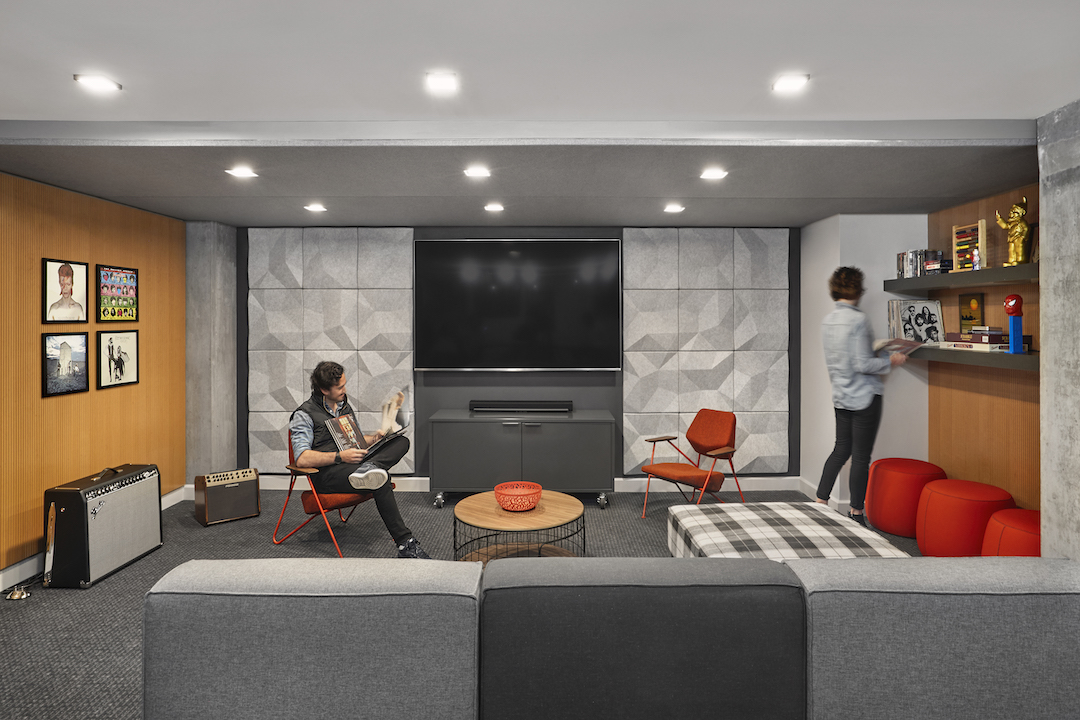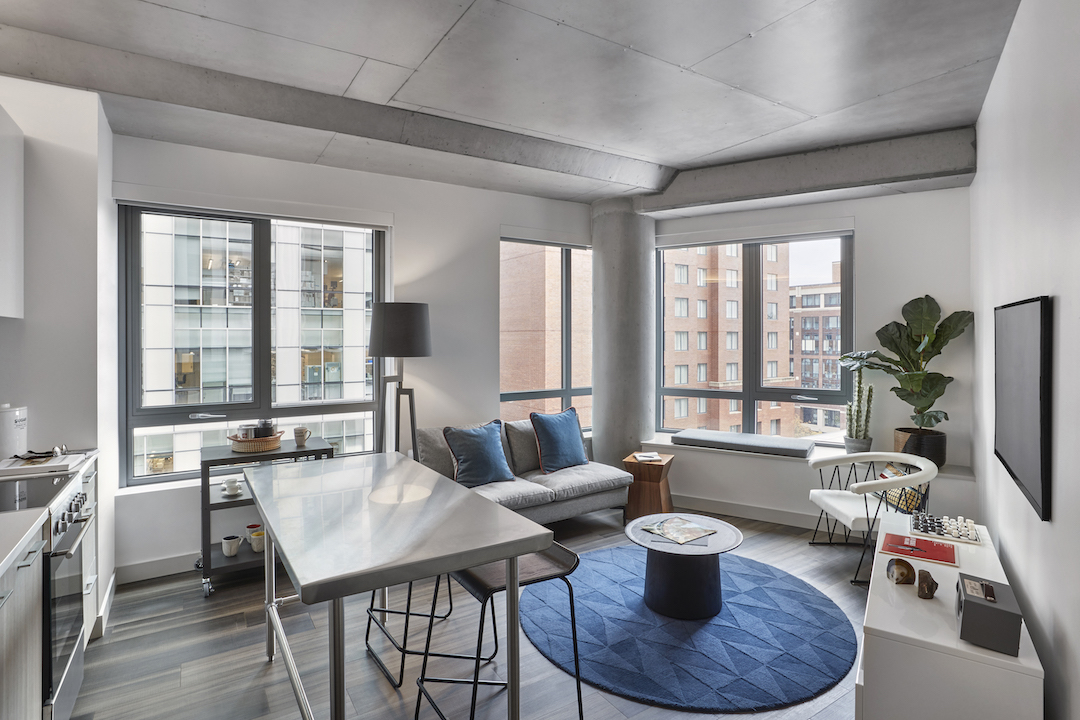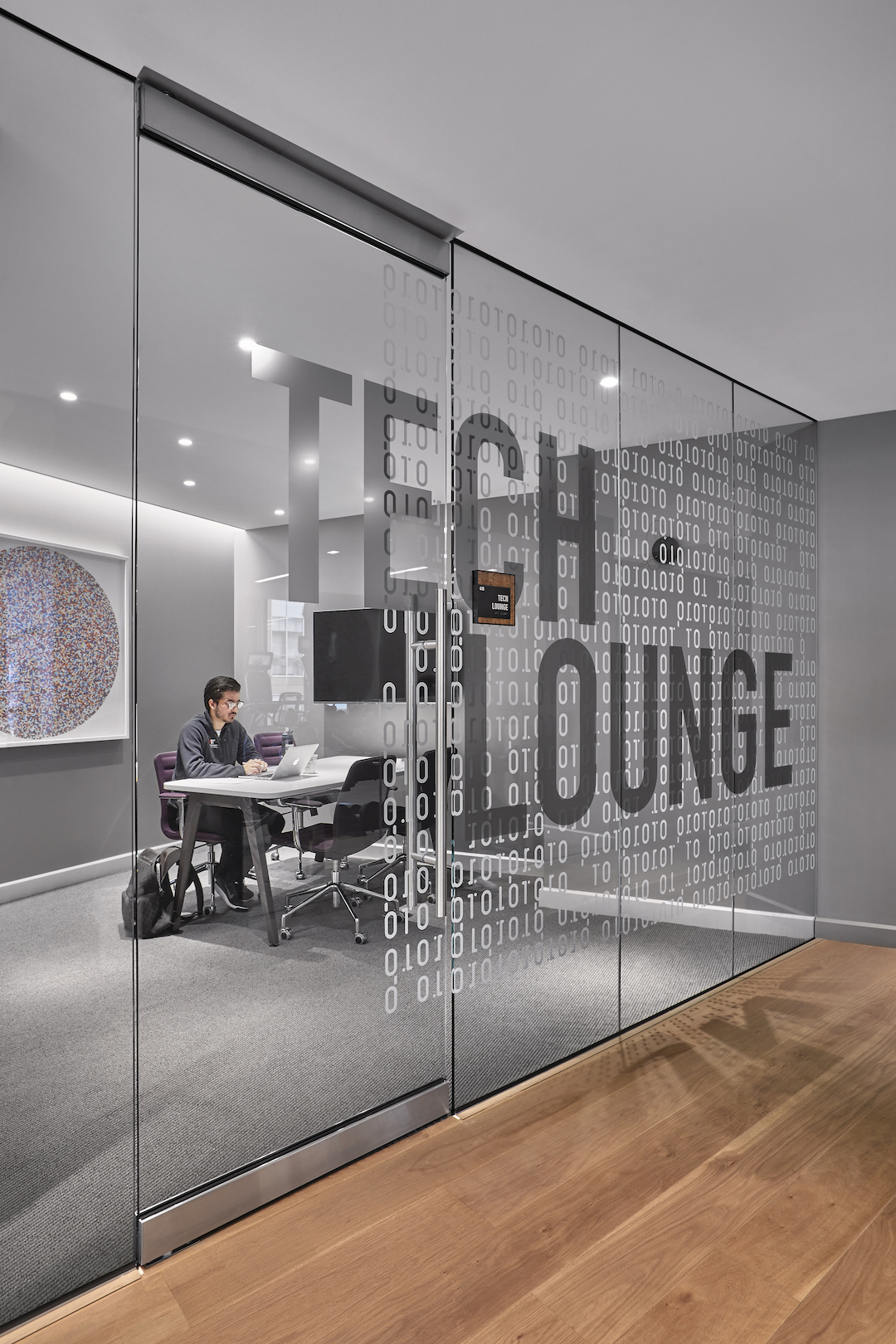A shortage of rental housing in the bustling Kendall Square neighborhood of Cambridge, Mass.—a hub of top-tier universities, research centers, and tech companies—prompted the development of Proto Kendall Square.
Boston Properties commissioned the 22-story, 280-unit apartment tower to help diversify the neighborhood’s office-centric property mix and expand its own multifamily portfolio. “We wanted to demonstrate the value of bringing high-quality rental property to a part of the city where we control a lot of commercial property,” said Boston Properties Project Manager Keir Evans.
Design architect FXCollaborative was tapped to develop the concept for a striking landmark on Ames Street, a minor access road that leads to two parking garages and a loading dock. Located within walking distance of dozens of tech employers and institutions, the site is served by the MBTA Red Line (known as the “Brain Train” for its role in transporting students to and from Harvard and MIT).
 The Garage, a cozy space where residents can hook up an electric guitar, play video games on a big-screen TV, or just kick back and enjoy the kitschy pop culture artwork.
The Garage, a cozy space where residents can hook up an electric guitar, play video games on a big-screen TV, or just kick back and enjoy the kitschy pop culture artwork.
The new structure had to fit within a tight triangular parcel which was formed by razing part of an existing parking garage and narrowing the street to create a bike lane and improve the pedestrian experience.
The goal: “to create a building that had presence, but was respectful of its dense context,” said Gustavo Rodriguez, AIA, LEED AP, Partner and Design Director at FXCollaborative in New York. “We had to strike a delicate balance between providing a sense of openness and a sense of privacy, both for tenants and for the surrounding offices.”
See Also: Eight projects showcase the latest trends in student housing
The design firm specified precast panels and punched windows to give the façade varying levels of transparency at different sections of the structure, informed by the proximity of that section to adjacent office buildings. Larger windows at the corners provide residents with scenic views of the Charles River and Boston skyline. “The building is constantly at play as you move around it, opening and closing to balance privacy and access to natural light and air,” said Rodriguez.
 A typical Proto apartment, 36 of which are classified as affordable. Unit amenities include Nest smart thermostats, ELFA closets, Thermofoil kitchen cabinets, keyless FOB entry, and operable windows.
A typical Proto apartment, 36 of which are classified as affordable. Unit amenities include Nest smart thermostats, ELFA closets, Thermofoil kitchen cabinets, keyless FOB entry, and operable windows.
At ground level, Proto features a modest pass-through lobby and four street-facing retail spaces occupied by a Mediterranean restaurant, coffee shop, florist, and bank.
The mix of the apartments is heavily studio (145 units) and one-bedroom units (90), appealing to the neighborhood’s sizable population of graduate students and millennial STEM workers. There are 43 two-bedroom units and a pair of three-bedroom apartments designed with families in mind. Thirteen percent of the units have been set aside to provide affordable housing.
DESIGNING FOR ‘THE SMARTEST PEOPLE IN THE WORLD’
“Thinking about where the smartest people in the world want to live was a really interesting design challenge,” said Colleen Arria, Principal at Stantec Architecture’s Boston office, which served as architect of record and interior designer. “Because the site was so tight, we had to be incredibly smart about how we planned every square inch of space.”
As you might expect, Proto’s apartments and common spaces integrate high-tech amenities, from smart thermostats to blazing-fast WiFi.
But the design team also created several high-touch amenity spaces that provide opportunities for residents to interact.
 Proto’s third-floor lounge serves as a communal living room for the micro-units on that floor. All residents enjoy 24-hour concierge and ButterflyMX entry system, a dedicated package room with Luxor management system, video gaming systems, a fireside lounge, a communal kitchen, a fitness center, a yoga and spin studio, and a pet spa with dog run.
Proto’s third-floor lounge serves as a communal living room for the micro-units on that floor. All residents enjoy 24-hour concierge and ButterflyMX entry system, a dedicated package room with Luxor management system, video gaming systems, a fireside lounge, a communal kitchen, a fitness center, a yoga and spin studio, and a pet spa with dog run.
The third level houses compact studio apartments and several lounge and co-working areas. It features a unique laundry lounge that doubles as a social space where residents can play board games or watch TV.
The fourth level has a large kitchen that opens to a communal living room area with a ping-pong table and outdoor terrace. Other amenities: a fitness center with a yoga and spin studio, a pet spa, and an adjacent dog run.
The fourth level also offers “The Garage,” a cozy multipurpose space reminiscent of a basement rec room suitable for a replay of “Bill and Ted’s Excellent Adventure.” Initially envisioned as a storage area due to its low ceilings and lack of windows, the space was reconfigured into a casual hideaway where residents could express their creativity.
“As we’ve designed other urban residences for highly educated communities, we’ve found these folks appreciate having a place where they can express themselves—by playing instruments, crafting, or building models—in an environment where they can get messy and not disturb other people,” said Stantec’s Arria.

Throughout the residential community, Proto’s modern, upscale design aesthetic incorporates comfy furniture and an abundance of exposed concrete. Other design elements pay homage to Kendall Square’s rich history—its early connections to NASA, ongoing leadership in the biotech industry, and historic role as a global center of research and innovation. A custom-made rug is emblazoned with excerpts from President John F. Kennedy’s legendary speech on the national role of space exploration.
“The design is really steeped in this idea of science, science fiction, and fantasy—with nods to pop culture icons from Star Wars to David Bowie,” said Timothy Reagen, LEED AP BD+C, Designer/Manager at Stantec. “To us, these elements just resonated with the idea of exploration into the infinite possibilities that science has to offer.”
Built at a cost of $108.7 million, Proto Kendall Square opened in June 2018 and achieved 97% occupancy in its first year of operation.
“It’s garnering the highest per-square-foot rent in the city right now, with a lease renewal rate of over 50%, which is reassuring that the environment that we created is successful and well recieved by residents," said Evans.
Related Stories
Urban Planning | Jun 15, 2023
Arizona limits housing projects in Phoenix area over groundwater supply concerns
Arizona will no longer grant certifications for new residential developments in Phoenix, it’s largest city, due to concerns over groundwater supply. The announcement indicates that the Phoenix area, currently the nation’s fastest-growing region in terms of population growth, will not be able to sustain its rapid growth because of limited freshwater resources.
Multifamily Housing | Jun 15, 2023
Alliance of Pittsburgh building owners slashes carbon emissions by 45%
The Pittsburgh 2030 District, an alliance of property owners in the Pittsburgh area, says that it has reduced carbon emissions by 44.8% below baseline. Begun in 2012 under the guidance of the Green Building Alliance (GBA), the Pittsburgh 2030 District encompasses more than 86 million sf of space within 556 buildings.
Industry Research | Jun 15, 2023
Exurbs and emerging suburbs having fastest population growth, says Cushman & Wakefield
Recently released county and metro-level population growth data by the U.S. Census Bureau shows that the fastest growing areas are found in exurbs and emerging suburbs.
Engineers | Jun 14, 2023
The high cost of low maintenance
Walter P Moore’s Javier Balma, PhD, PE, SE, and Webb Wright, PE, identify the primary causes of engineering failures, define proactive versus reactive maintenance, recognize the reasons for deferred maintenance, and identify the financial and safety risks related to deferred maintenance.
Mixed-Use | Jun 12, 2023
Goettsch Partners completes its largest China project to date: a mixed-used, five-tower complex
Chicago-based global architecture firm Goettsch Partners (GP) recently announced the completion of its largest project in China to date: the China Resources Qianhai Center, a mixed-use complex in the Qianhai district of Shenzhen. Developed by CR Land, the project includes five towers totaling almost 472,000 square meters (4.6 million sf).
Mixed-Use | Jun 6, 2023
Public-private partnerships crucial to central business district revitalization
Central Business Districts are under pressure to keep themselves relevant as they face competition from new, vibrant mixed-use neighborhoods emerging across the world’s largest cities.
Multifamily Housing | Jun 6, 2023
Minnesota expected to adopt building code that would cut energy use by 80%
Minnesota Gov. Tim Walz is expected to soon sign a bill that would change the state’s commercial building code so that new structures would use 80% less energy when compared to a 2004 baseline standard. The legislation aims for full implementation of the new code by 2036.
Student Housing | Jun 5, 2023
The power of student engagement: How on-campus student housing can increase enrollment
Studies have confirmed that students are more likely to graduate when they live on campus, particularly when the on-campus experience encourages student learning and engagement, writes Design Collaborative's Nathan Woods, AIA.
Multifamily Housing | Jun 1, 2023
Income-based electric bills spark debate on whether they would harm or hurt EV and heat pump adoption
Starting in 2024, the electric bills of most Californians could be based not only on how much power they use, but also on how much money they make. Those who have higher incomes would pay more; those with lower incomes would see their electric bills decline - a concept known as income-based electric bills.
Multifamily Housing | May 30, 2023
Boston’s new stretch code requires new multifamily structures to meet Passive House building requirements
Phius certifications are expected to become more common as states and cities boost green building standards. The City of Boston recently adopted Massachusetts’s so-called opt-in building code, a set of sustainability standards that goes beyond the standard state code.

















